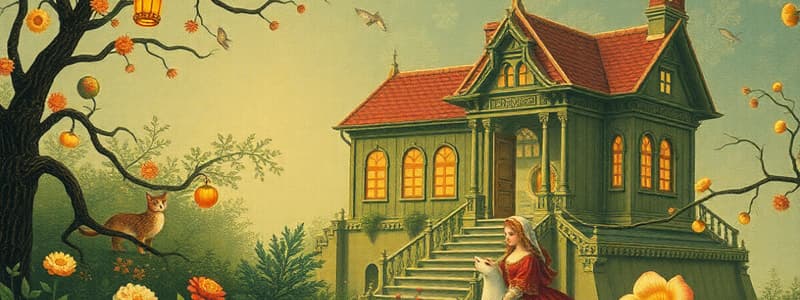Podcast
Questions and Answers
Considering the dialogical exchange and Kirsti's interjection concerning Amalienborg, which inference regarding the narrative's latent socio-political subtext is most tenable?
Considering the dialogical exchange and Kirsti's interjection concerning Amalienborg, which inference regarding the narrative's latent socio-political subtext is most tenable?
- Kirsti's interpolation signifies a rudimentary comprehension of national symbols, indicative of a pervasive, albeit nascent, patriotic consciousness being inculcated. (correct)
- The narrative overtly allegorizes contemporary Danish anxieties regarding monarchical succession and stability, subtly critiquing the institution.
- The mention of Amalienborg serves primarily as a whimsical non sequitur, introduced to disrupt narrative flow and underscore Kirsti's capricious disposition, devoid of deeper political resonance.
- The reference to Amalienborg functions as a subtle metonym for established authority, implicitly contrasting the fantastical realm of fairy tales with the tangible structures of governance.
If the narrative excerpt is posited as a microcosm of intergenerational transmission of cultural narratives, which hermeneutic lens would be most efficacious in deciphering the latent pedagogical dynamics at play between Annemarie and Kirsti?
If the narrative excerpt is posited as a microcosm of intergenerational transmission of cultural narratives, which hermeneutic lens would be most efficacious in deciphering the latent pedagogical dynamics at play between Annemarie and Kirsti?
- A Foucauldian analysis, emphasizing the power dynamics inherent in storytelling and the subtle disciplinary mechanisms embedded within seemingly innocuous narratives.
- A Derridean deconstructive reading, aimed at dismantling the binary opposition between 'reality' (Amalienborg) and 'fantasy' (fairy tales), revealing the inherent instability of meaning within the dialogue.
- A Lacanian psychoanalytic approach, focusing on Kirsti's desire for symbolic paternal figures within the fairy tale narrative, reflecting unresolved Oedipal anxieties.
- A Vygotskian sociocultural perspective, highlighting Annemarie's role as a more knowledgeable other scaffolding Kirsti's understanding of narrative structures and cultural motifs. (correct)
Assuming the broader narrative context, 'a book about the number of stars,' functions as a diegetic and thematic anchor, how does the sisters' interaction regarding fairy tales most likely contribute to the overarching narrative arc?
Assuming the broader narrative context, 'a book about the number of stars,' functions as a diegetic and thematic anchor, how does the sisters' interaction regarding fairy tales most likely contribute to the overarching narrative arc?
- It establishes a symbolic dichotomy between the infinite expanse of the cosmos (stars) and the finite, structured narratives of fairy tales, highlighting existential limitations.
- It introduces a motif of childlike wonder and imagination, contrasting with potentially more mature or pragmatic themes related to 'the number of stars' explored elsewhere in the narrative. (correct)
- It operates as a thematic red herring, intentionally diverting reader expectations from the literal interpretation of 'stars' to a more metaphorical exploration of interpersonal relationships.
- It serves as a narrative prolepsis, foreshadowing subsequent plot developments wherein celestial navigation or astronomical events will become central to the unfolding story.
Given the mention of Hans Christian Andersen within the implied cultural milieu, and considering the sisters' preference for 'The Little Mermaid,' what critical interpretation best elucidates the significance of this intertextual reference within the excerpt's framework?
Given the mention of Hans Christian Andersen within the implied cultural milieu, and considering the sisters' preference for 'The Little Mermaid,' what critical interpretation best elucidates the significance of this intertextual reference within the excerpt's framework?
Analyzing the narrative structure, if the excerpt represents the exposition of a larger work, what primary function does the dialogue between Annemarie and Kirsti serve within the expected Aristotelian dramatic arc?
Analyzing the narrative structure, if the excerpt represents the exposition of a larger work, what primary function does the dialogue between Annemarie and Kirsti serve within the expected Aristotelian dramatic arc?
Considering the request for a fairy tale beginning with 'a king and a queen and a lovely daughter,' and juxtaposing it with Kirsti's interruption about Amalienborg, which theoretical framework best elucidates the interplay between archetypal narrative structures and children's cognitive schema formation?
Considering the request for a fairy tale beginning with 'a king and a queen and a lovely daughter,' and juxtaposing it with Kirsti's interruption about Amalienborg, which theoretical framework best elucidates the interplay between archetypal narrative structures and children's cognitive schema formation?
If the phrase 'Who Is the Man Who Rides Past?' from the implied book title were to be interpreted as a metafictional cue embedded within this excerpt, what plausible metanarrative function could this question serve in relation to the sisters' dialogue?
If the phrase 'Who Is the Man Who Rides Past?' from the implied book title were to be interpreted as a metafictional cue embedded within this excerpt, what plausible metanarrative function could this question serve in relation to the sisters' dialogue?
Flashcards
Annemarie
Annemarie
One of the sisters in the story who tells the fairy tale.
Kirsti
Kirsti
The younger sister who wants to hear a story.
Fairy Tale
Fairy Tale
A type of story that often includes magical elements and characters.
Amalienborg
Amalienborg
Signup and view all the flashcards
King and Queen
King and Queen
Signup and view all the flashcards
Little Mermaid
Little Mermaid
Signup and view all the flashcards
Hans Christian Andersen
Hans Christian Andersen
Signup and view all the flashcards
Study Notes
Story Request
- Kirsti, a young girl, asks Annemarie for a story.
- Annemarie agrees and tells a fairy tale.
- The story starts with a king and queen and their beautiful daughter.
Danish Fairy Tales
- Danish children were familiar with fairy tales.
- Hans Christian Andersen was a famous Danish fairytale writer.
Studying That Suits You
Use AI to generate personalized quizzes and flashcards to suit your learning preferences.



